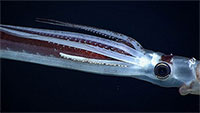NOAA and Schmidt Ocean Institute Webinar for Educators:
Discovering Deep-Sea Corals of the Phoenix Islands
September 27, 2017

Squid holding onto another squid. Image courtesy NOAA OER.
NOAA's Office of Ocean Exploration and Research and Schmidt Ocean Institute (SOI) invite educators to a webinar to introduce the science and associated educational resources available for the 2017 Discovering Deep-sea Corals of the Phoenix Islands expedition, October 5 - November 1.
For the past three years, NOAA Ship Okeanos Explorer has conducted expeditions in the central and western Pacific Ocean as part of a multi-year effort called the 'Campaign to Address Pacific monument Science, Technology, and Ocean NEeds (CAPSTONE).' During this October expedition, Schmidt Ocean Institute will explore new areas of the Phoenix Island Protected Area (PIPA), expanding on the work that NOAA did during this Campaign.
PIPA lies about halfway between Hawaii and Fiji and is the largest and deepest UNESCO World Heritage Site on Earth. It also was the first marine protected area (MPA) of its kind. This region includes huge tracts of deep ocean pierced with underwater volcanoes, seamounts, atolls, and submerged reefs, creating an isolated, virtually untouched coral archipelago ecosystem. The shallows host hundreds of ocean species, but PIPA is also the first Pacific protected area where depths exceed 5,000 meters, and entirely unknown species are sure to live at those depths.
Questions for this expedition include: Why does this biodiversity exist in the deep sea and what sort of connections are there between shallow water environments and the deep sea?
Aboard the R/V Falkor, scientists will explore PIPA using multibeam sonar, SOI's remotely operated vehicle, SuBastian, and other tools and sensors. ROV dives will be streamed live from SOI's YouTube page ![]() and website (schmidtocean.org
and website (schmidtocean.org ![]() ).
).
This 60-minute webinar will introduce the expedition, associated education products, and online resources.
Date: Wednesday, September 27, 2017
Time: 4:00 PM EDT
Questions: susan.haynes@noaa.gov
